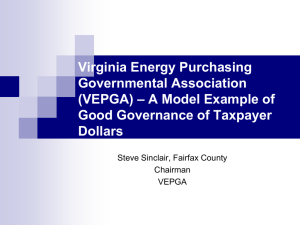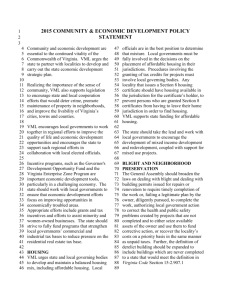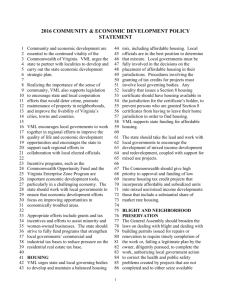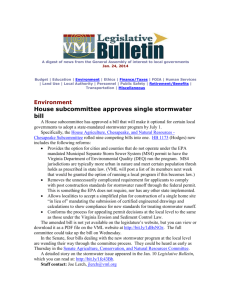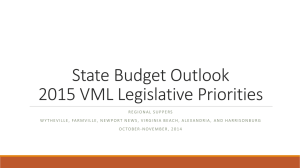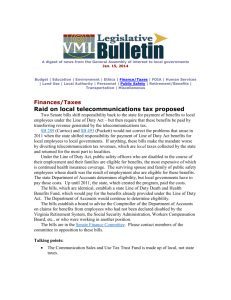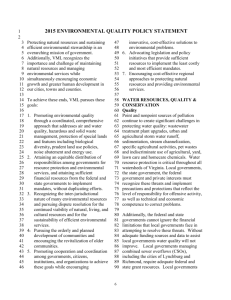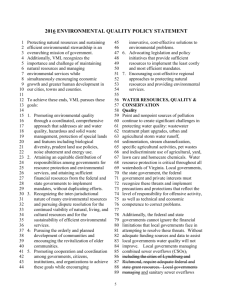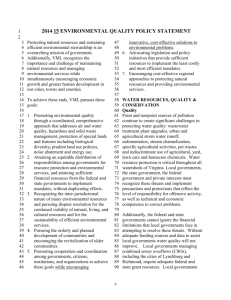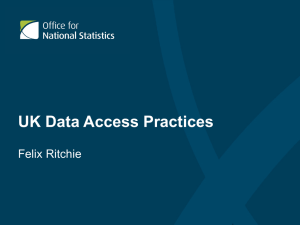Analysis: Proposed amendments to FY2014 budget
advertisement
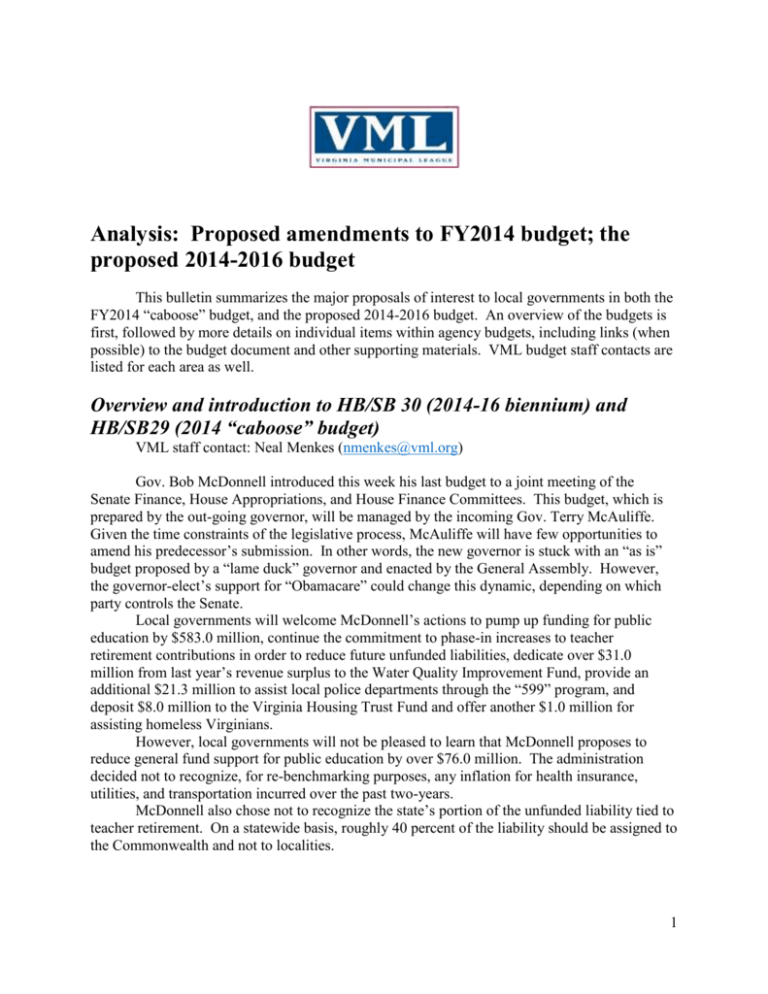
Analysis: Proposed amendments to FY2014 budget; the proposed 2014-2016 budget This bulletin summarizes the major proposals of interest to local governments in both the FY2014 “caboose” budget, and the proposed 2014-2016 budget. An overview of the budgets is first, followed by more details on individual items within agency budgets, including links (when possible) to the budget document and other supporting materials. VML budget staff contacts are listed for each area as well. Overview and introduction to HB/SB 30 (2014-16 biennium) and HB/SB29 (2014 “caboose” budget) VML staff contact: Neal Menkes (nmenkes@vml.org) Gov. Bob McDonnell introduced this week his last budget to a joint meeting of the Senate Finance, House Appropriations, and House Finance Committees. This budget, which is prepared by the out-going governor, will be managed by the incoming Gov. Terry McAuliffe. Given the time constraints of the legislative process, McAuliffe will have few opportunities to amend his predecessor’s submission. In other words, the new governor is stuck with an “as is” budget proposed by a “lame duck” governor and enacted by the General Assembly. However, the governor-elect’s support for “Obamacare” could change this dynamic, depending on which party controls the Senate. Local governments will welcome McDonnell’s actions to pump up funding for public education by $583.0 million, continue the commitment to phase-in increases to teacher retirement contributions in order to reduce future unfunded liabilities, dedicate over $31.0 million from last year’s revenue surplus to the Water Quality Improvement Fund, provide an additional $21.3 million to assist local police departments through the “599” program, and deposit $8.0 million to the Virginia Housing Trust Fund and offer another $1.0 million for assisting homeless Virginians. However, local governments will not be pleased to learn that McDonnell proposes to reduce general fund support for public education by over $76.0 million. The administration decided not to recognize, for re-benchmarking purposes, any inflation for health insurance, utilities, and transportation incurred over the past two-years. McDonnell also chose not to recognize the state’s portion of the unfunded liability tied to teacher retirement. On a statewide basis, roughly 40 percent of the liability should be assigned to the Commonwealth and not to localities. 1 In addition, the administration decided to move ahead with its initiative from last session to establish the Opportunity Educational Institution (OEI) at $600,000 each year, although the legislation faces a stiff judicial challenge. The bottom line is that state general fund support for state-mandated and high-priority programs carried out by local governments will continue to shrink as a portion of the general fund, falling from 52.0 percent in FY 2009 to a projected 43.7 percent in FY 2016. State GF Assistance is Declining as a Percentage of the Budget $8.5 54.0% 52.0% 50.0% 48.0% 46.0% 44.0% 42.0% 40.0% 38.0% $8.0 $7.5 $7.0 $6.5 FY09 FY10 FY11 *2013 Session; ^Proposed FY12 FY13 FY14* FY14^ FY15^ FY16^ Appropriations Budget assumes continuing modest economic expansion For the new biennium, general fund revenues are expected to grow 4.2 percent in FY 2015 and 3.9 percent in FY 2016. These figures are based on a new budget paradigm that Virginia’s economy will no longer outperform the nation’s economic growth. The slow rate of job growth over the next three years and federal sequestration are expected to constrain growth in general fund revenue collections. In this fiscal year, total revenues available for general fund appropriations are, thus far, increasing by 0.7 percent, behind the official estimate of 1.7 percent. TAX SOURCE INDIVIDUAL INCOME SALES CORPORATE INSURANCE ACTUAL FY13 6.9% FORECAST FY14 3.7% FORECAST FY15 5.1% FORECAST FY16 4.6% 3.1% (7.3%) 2.5% (4.4%) 0.4% 10.4% 3.1% 2.1% 0.5% 2.6% 0.7% 4.2% The state’s revenue model also predicts flat growth over the next three fiscal years for recordation tax collections. This is important to localities as over half of local-generated revenue is derived from property taxes. The state’s economic model assumes the housing market has stabilized but increases in mortgage rates have constrained refinancing activity and will continue to do so. 2 Overall budget continues to grow The McDonnell budget weighs in at a record-setting $95.9 billion for the biennium. This breaks down to $58.2 billion in non-general fund spending and $37.7 billion in general fund spending. Non-general fund items include money from federal grants for programs like Medicaid, institutional revenue paid with patient fees at behavioral health institutions and teaching hospitals as well as college tuition and fees, transportation taxes, unemployment insurance dollars, and the master tobacco settlement agreement fund. The $37.7 billion of capital and operating general fund spending is almost 7.4 percent ($2.6 billion) greater than the general fund spending approved last session. As has been the case for several years, Medicaid and public education dominate the budget, accounting for 52.0 percent of state general fund dollars. Allocation of General Fund Dollars HB/SB 30 ($s in billions) $8.5 , 22% $11.2 , 30% $1.9 , 5% $1.4 , 4% $2.2 , 6% $8.3 , 22% $3.5 , 9% $0.7 , 2% Direct Aid to Public Education Higher Educ BHDS Medicaid Corrections Debt Service Car Tax Relief Other This budget includes $939.6 million in budget cuts comprised of technical and base budget adjustments ($688.9 million) as well as targeted cuts ($250.7 million). Over half of the targeted cuts are in public education at $145.6 million. McDonnell’s spending plans reflect the priorities he articulated to the General Assembly’s money committees. More than $300 million will be deposited to the Rainy Day Fund, increasing the Fund’s balance to $1.0 billion by FY 2016. McDonnell also proposes a $50.9 million unappropriated balance; the largest since unappropriated balance since 1991. 3 More than 80% of new spending is in these amendments; New Medicaid spending exceeds new K-12 spending by $100 million ($s in billions) AGENCY Dept of Medical Assistance Services Direct Aid to Public Education Dept of Accounts Treasury Board Direct Aid to Public Education Central Appropriations Central Appropriations Dept of Medical Assistance Services Central Appropriations PROGRAM Medicaid SOQ Rainy Day Fund State Debt Teacher Retirement State Employee Retirement State Health Insurance Pgm Waiver Slots Repayment to VRS Biennial Total $674.4 $575.2 $303.1 $196.7 $161.7 $97.6 $83.9 $124.1 $53.6 Introduction to HB/SB 29 (Caboose Bill) The caboose bill has a normal shelf life of 2-3 months. The bill’s purpose is to provide the governor and the General Assembly one final opportunity to adjust revenues and spending in the closing months of a biennium. Gov. Bob McDonnell proposes a net general fund reduction of $249.1 million. The mix of amendments include targeted savings of $21.6 million, new spending of $33.3 million, and technical amendments cutting $260.9 million. The good news for local governments is a proposal to increase per diem payments to local and regional jails by $4.5 million. There is also an increase of $3.4 million for child welfare services. The table below summarizes the major actions taken in the caboose bill. Agency Dept of Medical Assistance Services Dept of Medical Assistance Services Direct Aid to Public Education Direct Aid to Public Education Direct Aid to Public Education Dept of Medical Assistance Services Direct Aid to Public Education Amendment Adjust for more non-general fund money Amount Adjust for utilization and inflation ($73.6) Update Lottery proceeds for K-12 ($55.2) Adjust sales tax funds for K-12 Cut unclaimed appropriations for teacher pay raises Family Access to Medical Insurance Security program Update costs of incentive, categorical & Lottery programs ($16.7) ($90.3) ($9.3) ($8.6) ($7.9) 4 Central Appropriations Treasury Board Dept of Medical Assistance Services Dept of Social Services Compensation Bd Direct Aid to Public Education Agency savings strategies Debt management savings Medical assistance services for lowincome kids utilization & inflation Child Welfare Services Per diem payments to local/reg jails Rising student enrollments Other spending amendments TOTALS ($3.8) ($3.6) ($2.9) $3.4 $4.5 $11.9 $2.9 ($249.2) HB/SB 29 (FY2014, the current year budget) The following is a summary of items of interest to local governments in HB/SB29, the budget bill to amend the current fiscal year budget (FY14). This “caboose budget” makes changes to the final months of the second year of the two-year budget (2012-2014). State aid and transfer payments to local government VML staff contact: Janet Areson (jareson@vml.org) State assistance to local law enforcement (HB 599 program). No changes to the level of funding approved by the 2013 General Assembly ($172.4 million) Tennessee Valley Authority (TVA) payments. Increases the payments in lieu of taxes by $200,000, bringing the total distribution to $1.4 million this fiscal year. Administration VML staff contacts: Janet Areson (jareson@vml.org), Mary Jo Fields (mfields@vml.org) Compensation Board Jail per diem payments. Increases funding by $4.5 million to pay the state share of costs for the remainder of this fiscal year. The Compensation Board says that this is about half the amount necessary to meet the projected costs according to growth percentages approved by the Inmate Population Forecasting Committee earlier this fall. The Committee will meet to revisit this projection in early January. Board of Elections VML staff contact: Mary Jo Fields (mfields@vml.org) Recount costs. The budget includes $50,000 to reimburse state agencies for costs connected with the recount for the Attorney General’s race, but contains no funding to reimburse cities and counties for their costs. 5 Compensation and retirement VML staff contact: Mary Jo Fields (mfields@vml.org) State employee bonus. The budget includes funding for a 2 to 3 percent bonus for state employees, effective Dec. 1, 2014, contingent on agency savings in discretionary spending and revenue growth but there is no funding for bonuses for teachers or statesupported local employees (such as constitutional offices, social services department, etc.). Public Education - Direct Aid to Education VML staff contact: Mary Jo Fields (mfields@vml.org) The Superintendent of Public Instruction’s memorandum on the public education budget gives the most details on technical and other changes included in the budget amendments for FY14. The budget decreases direct aid to education by $21.9 million, primarily reflecting changes in sales tax collection, student enrollment and participation in incentive, categorical and Lottery-funded programs (including programs such as pre-K and reduced class size). Lottery funds are projected to be $33 million higher in FY14 than included in the current budget. The budget removes $9.3 million from the $70.2 million compensation account, reflecting the fact that around 15 school divisions did not give a 2 percent (or higher) salary increase for teachers and other instructional personnel, and therefore did not receive the state incentive funding to do so. There is a language amendment to clarify that state funding for education of children in detention homes can be used only for children who have been placed in detention homes by a state court. Evidently the intent is to ensure that detention homes that receive federal funding for the education of undocumented children do not also receive state funding for the same child. (Item 139 C 19 c) The amendment is also included in the budget for FY2015 and FY2016. Economic Development VML staff contact: Neal Menkes (nmenkes@vml.org) Fort Monroe Authority. Adds $701,630 for operating the Fort Monroe Authority. Health & Human Resources VML staff contact: Janet Areson (jareson@vml.org) Department of Social Services Temporary Assistance for Needy Families. Reduces funding by $18.6 million (nongeneral funds) to account for anticipated costs for this fiscal year. Auxiliary Grants. Reduces funding by $2 million to account for the latest spending projections for this year. 6 Public Safety VML staff contact: Janet Areson (jareson@vml.org) Juvenile Justice Culpeper correctional center. Initiates a change from a juvenile facility to an adult women’s facility. This includes the closing of two halfway houses in Jan. 2014 and freezing employment at the center in anticipation of its change-over for a savings of $2.7 million. Transportation VML staff contact: Joe Lerch (jlerch@vml.org) Discretionary funding of transportation projects. Proposed budget language would allocate $31 million in unused general funds assigned five-years ago for specific transportation projects to the Transportation Partnership Opportunity Fund (TPOF). The money would be used at the discretion of the Governor. The original authority to spend the money has expired, and it is questionable if the funds can be spent without new authorization. TPOF funds come in the form of grants (capped at $5 million per project) and no-interest loans (capped at $30 million per project) for public-private partnerships or localities. (Item 446 I) HB/SB 30, the proposed 2014-2016 budget The following is a summary of proposed actions to take place in the budget that will begin July 1, 2014. As with HB/SB29, this summary begins with state assistance to local government and then is generally organized by secretariat (administration, education, etc.) Everything outlined here is a proposal – the General Assembly will review and make its own changes to this proposal before it becomes law. State assistance and transfer payments to local governments VML staff contact: Janet Areson (jareson@vml.org) State assistance to local law enforcement (HB 599 program). Increases funding to this program by $7.1 million in FY2015 (for a total of $179.5 million) and by $14.24 million in FY2016 (for a total of $186.7 million). This is the first appropriation increase for this program since the 2007 Session. As recently as FY2009, the funding level for this program was $197.3 million. Recordation taxes. Maintains the $40 million distribution in each year. Tennessee Valley Authority (TVA) payments. Proposes $1.4 million for each year. Rental vehicle tax distribution. Maintains the $36 million distribution in each year. 7 Rolling stock taxes. Proposes a funding level of $6.9 million each year. Communication sales and use tax. Maintains a funding level of $440 million each year. Virginia wireless tax for enhanced emergency communications. Increases the amount to be distributed by $11.8 million in the first year (for a total of $33 million) and by $14.8 million in the second year (for a total of $36 million). ABC profits/wine taxes. Although the Code of Virginia still authorizes the sharing of ABC profits/wine taxes with local governments, the state no longer shares any proceeds of this growing revenue stream with local governments. Local fines and fees to be transferred to Literary Fund Deposit of Fines and Fees. Maintains state practice of keeping a certain amount of fines and fees assessed by local ordinances when such fees exceed 50.0 percent of the total state and local collections. Administration VML staff contacts: Janet Areson (jareson@vml.org); Mary Jo Fields (mfields@vml.org) Compensation Board Jail overcrowding. Adds $1.54 million in FY2015 and 1.7 million in FY2016 to pay for 48 temporary (emergency) correctional officers for local and regional jails with overcrowding rates exceeding 100 percent of operational capacity. Additional law enforcement deputies. Adds $928,203 and 29 positions in FY2015 and $2.1 million and an additional 33 positions in FY2016 to support a total of 62 new law enforcement deputies. According to the Comp Board, this represents 25 percent and 50 percent of the positions needed to meet the statutory requirement of one deputy per 1,500 residents in a locality. Master deputy/jail officer programs. Adds $390,575 each year to allow for additional participants in the sheriffs’ and regional jail master deputy/jail officer programs. Jail per diem payments. Adds no additional funding for the projected need of $10.7 million in FY2015 and $11.7 million in FY2016 for jail per diem payments, based upon growth percentages provided by the Inmate Population Forecasting Committee. The state instead waits until the actual fiscal year to add funding to meet the need for that particular year. New jail positions resulting from expansions/construction. Adds 88 positions beginning Oct. 1, 2014, and funding for them ($1.97 million in Fy2015 and $3.09 in FY2016) for the Rappahannock/Shenandoah/Warren Regional Jail; adds 144 positions beginning Nov. 1, 2014 and funding for them ($2.62 million in FY2015 and $4.68 in 8 FY2016) for expansion of the Southwest VA Regional Jail; technical adjustment providing $276,069 in each year to support annualized costs of staffing associated with the replacement of the Richmond City Jail funded to open Jan. 2014. No funding was added for the expansion of Central Virginia Regional Jail, which is scheduled to be completed in Jan. 2016. Agricultural & Forestry VML staff contact: Joe Lerch (jlerch@vml.org) Agriculture and forestry incentive grants. Proposes $1.25 million each year of the biennium for the Governor's Agriculture and Forestry Industries Development Fund (AFID). AFID grants and loans are available to local governments to attract new and expanding agriculture and forestry processing facilities that use Virginia-grown products. For example, the City of Harrisonburg was recently awarded an AFID grant to assist in reopening a shuttered chicken processing plant that will now process locally-grown organic birds. (Item 89) Compensation and retirement VML staff contact: Mary Jo Fields (mfields@vml.org) Salary increases. The budget includes funding for a 2 to 3 percent bonus for state employees, contingent on agency savings in discretionary spending and revenue growth but there is no funding for bonuses for teachers or state-supported local employees (such as constitutional offices, social services department, etc.). The budget includes a 2 percent increase for entry level deputy sheriffs and jail officer and for deputy clerks II. In addition, the budget includes 4 percent salary increase for entry level clerk positions. These raises include new language that states that says localities may not use the Compensation Board funding for the raises to supplant local funding. (Item 66 P 1, Item 71, M1, M2, N1, N2) This language is a problem as employees on local pay plans may start at salaries higher than those funded through the Compensation Board, but the language appears to require that even those employees would have to receive the increase. This penalizes localities who have been providing adequate salaries all along. As the second phase of an initiative begun last year, there is a dollar specific salary increase for assistant commonwealth’s attorneys. (Item 70 H) The Compensation Board has posted detailed information here. Fringe benefits. Teacher benefits are covered under Direct Aid below. For constitutional officers the budget includes $1.2 million in FY15 and FY16 for the increased cost of retiree health care insurance for employees funded through the Compensation Board. Note, however, that the state “recovers” $805,450 from localities to pay part of the costs of health retiree insurance. Public Education - Direct aid to education VML staff contact: Mary Jo Fields (mfields@vml.org) 9 The big number. The budget includes $5.57 billion for direct aid in FY15 and $5.62 billion in FY16. By comparison the direct aid amount in FY14 is $5.3 billion. Here are a few highlights. The best source for details in the public education budget is the memorandum produced by the Superintendent of Public Instruction. The attachments to the memorandum explain increases and decreases for various educational programs resulting from changes in enrollment, changes in sales tax distribution and other factors. Locality specific information showing required state and local shares for education costs is available as well. Some items deserving of special attention are summarized below. Rebenchmarking. The budget rebenchmarks (updates) most of the costs for public education except in two areas. The budget removes $10 million in each year to pay cost-of-competing for support positions in Northern Virginia school districts. It also eliminates the use of an inflation factor for non-personal services, for a reduction in state spending of more than $24 million a year in the biennium. Non-personal services include the costs of items such as utilities, insurance reported in the 2012 Annual School Reports. A true rebenchmarking will apply an inflation factor to bring those 2012 costs up to 2014, the start of the next biennium. This policy change means that the state will be basing its share of costs in FY15 and FY16 for utilities, transportation, utilities and similar items on what those services cost in 2012. This clearly is just a cost shift to localities, as is the removal of the COCA for support positions in NOVA. (Item 136) Opportunity Educational Institution. The budget includes $600,000 a year for administrative costs of the OEI, funded not through the direct aid section of the budget but as a separate state agency comparable to a college or university. Schools denied accreditation for two years shall be transferred to the OEI; the OEI board may elect to take over schools that are accredited with warning for three years. (The current budget limits the OEI take-overs to schools that are denied accreditation for two years.) The budget also adds language that attempts to ensure that the local perpupil funding transferred to the OEI will follow the student. (Item 138) Literary Fund. The budget includes $10 million a year from the Literary Fund for use for school construction loans. Teacher retirement. The budget includes the state share of funding for a 14.50 percent employer teacher retirement contribution rate, in line with the schedule adopted by the General Assembly in 2012 to phase in full funding of the rates certified by the VRS Board of Trustees. The phase-in is to be completed by the 201820 biennium. The credit rating agencies have made it very clear that the failure to follow the schedule will jeopardize the state’s credit rating. The current employer rate for teachers is 11.66 percent; a rate of 14.50 percent represents a significant increase, but the failure to fund the higher rate would jeopardize the state’s credit rating, add to the unfunded liability that will be shown on local government financial statements 10 and increase costs down the road. Here’s the table on retirement and fringe benefit from the Superintendent’s memo: FUNDED FRINGE BENEFIT RATES: Instructional & Professional Support VRS (Employer Share) (Does not include RHCC - see below) Instructional & Professional Support VRS (Employee Share) Total Instructional & Professional Support VRS Rate Group Life (Employer Share) Group Life (Employee Share) Total Group Life Rate Retiree Health Care Credit (Paid as part of the VRS Instructional retirement per pupil amount) Non-professional Support VRS Social Security Health Care Premium Total Instructional Benefit Percent (Employer Share) Total Non-professional Support Benefit Percent (Employer Share) FY 2014 11.66% FY 2015 14.50% FY 2016 14.50% 5.00% 5.00% 5.00% 16.66% 19.50% 19.50% 0.48% 0.71% 1.19% 1.11% 0.53% 0.71% 1.24% 1.18% 0.53% 0.71% 1.24% 1.18% 10.23% 7.65% $3,778 20.90% 18.36% 9.40% 7.65% $4,188 23.86% 17.58% 9.40% 7.65% $4,188 23.86% 17.58% Teacher salary increase. No state funding for a salary increase or bonus for teachers. Reading/math specialists. $1.8 million in each year for the state’s share of the cost for one reading or math specialist in schools that have been denied accreditation or have been accredited with warning for the third consecutive year. DOE also will identify 20 additional schools that have been accredited with warning for two years and have shown little improvement. Local match required. (Item 136, C 36 ) Special education state operated programs. Language amendment to clarify that state funding for education of children in detention homes can be used only for children who have been placed in detention homes by a state court. Evidently the intent is to ensure that detention homes that receive federal funding for the education of undocumented children do not also receive state funding for the same child. (Item 136, C 19 c) Extended learning time model. Adds $613,312 for planning or start-up grants for extended learning time models, preschool grants and grants for alternative instructional delivery or school governance models. At-risk schools (defined as those that are accredited with warning) would have preference in the grant process. (Item 135 C ) Communities in Schools. Increases appropriation to expand program to the city of Petersburg (Item 136, C J) Secretary of Education Governor’s schools. Directs Secretary to study the formula used to determine governor’s school payments, including the appropriate state and local shares. 11 Economic Development VML contact: Neal Menkes (nmenkes@vml.org) Mega Site Development. Proposes $2.0 million in FY16 to support the Major Employment and Investment (MEI) Site Planning Fund. The purpose of the fund is to assist political subdivisions with developing mega sites to attract high-impact regional economic development projects. Southwest Virginia Cultural Heritage Foundation. Proposes $300,000 in FY15 to support the Foundation’s operating and marketing expenses and to leverage additional state and federal grants. Rapid Rehousing. Supports the rapid rehousing program by adding $500,000 each year to the program, increasing total spending in each year to $1.0 million. Virginia Housing Trust Fund. Supports housing and homelessness assistance efforts with appropriations of $4.0 million each year to the trust fund. Entrepreneurial Accelerator Program. Establishes an accelerator program to help entrepreneurs grow sustainable start-ups through a network of business planning, technical assistance, mentoring, and access to capital. The amendment provides $250,000 each year. Offshore Oil and Gas Study. Proposes $250,000 in FY15 to study the feasibility of offshore oil and gas development. The study is to focus on Virginia’s readiness for such activities with particular emphasis on the infrastructure needed to support the industry as well as a plan to address any concerns raised by the military. Fort Monroe Authority. Establishes appropriations of $5.9 million each year for the Authority. Previous appropriations for the Authority were passed-through to the Authority from the Department of Housing and Community Development. Workforce Development in Central Virginia. Proposes $1.3 million in FY15 to support the workforce needs of the advanced manufacturing industry sector. Of this amount, $300,000 will be used to match funding from other public or private sources for planning of a regional training center. Finance VML staff contact: Neal Menkes (nmenkes@vml.org) Rainy Day Fund. Fulfills constitutional requirement by depositing $243.2 million in FY15 and $59.9 million in FY16 to the Revenue Stabilization Fund. These are mandatory deposits, and cannot be deferred. 12 Neighborhood Assistance Act Tax Credit. Increases the tax credit cap by $1.0 million in FY15 and by $2.0 million in FY16, raising the cap to $17.0 million in FY16. The credit may be claimed by businesses and individuals for donations to neighborhood organizations for state-approved programs that benefit impoverished people. Education is a permissible activity. Federal Action Contingency Trust Fund. Continues current budget language governing the use of the FACT Fund. The language also allocates a portion of the fund to meet the state’s contribution to address encroachment near the naval air station in Virginia Beach ($4.4 million) and to spur research and development at Virginia Tech for unmanned aircraft systems ($1.6 million). The FACT Fund has a balance of $11.3 million. School Efficiency Reviews. Proposes $325,000 each year to support the program administered by the Department of Planning and Budget for local school divisions. Each participating school division must pay a local share of the cost incurred by the state for the review to be conducted. Health & Human Resources VML staff contact: Janet Areson (jareson@vml.org) Comprehensive Services for At-Risk Youth and Families Foster care age extension. Reduces expenditures by $2.94 million in FY2016 for youth anticipated to be covered under federal child welfare subsidies after expanding the state’s foster care program to 18-21 year olds. Increase foster care rates. Increases state foster care maintenance payments associated with a cost of living adjustment authorized by the Appropriations Act. The total increase is $219,328 each year. Additional funds are included in the foster care/adoption subsidy payment program under social services. SAS data collection costs. Adds $300,000 each year to pay for the SAS data collection and local financial interface system that was previously paid for with program balances. Health Department Local dental services. Removes $967,944 GF/$696,362 NGF and 20 positions each year that was provided to temporarily allow the agency to continue its community dental program while making a transition to a preventive model, which is required to be in place by July 1, 2014. The deadline for implementation is extended for the Mount Rogers, Western Tidewater, and Norfolk health districts until Jan. 1, 2016. These districts will continue to provide the current community dental program for these additional 18 months. 13 Rescue squad assistance fund. Increases the appropriation for the Virginia Rescue Squad Assistance Fund by $1.5 million each year from increased revenue from the $6.25 For Life fees. Local health department rent. Provides $176,929 GF/$103,503 NGF in FY2015 and $387,744 GF/$267,602 NGF in FY2016 for additional costs to local health departments as they move to new facilities with higher rental costs. Resource mothers program. Adds $614,914 each year to maintain funding for this program, which no longer receives federal funding. This funding will all program sites and programs. Poison control centers. Reduces funding by $300,000 each year to reflect funding of two centers, as opposed to three. Department of Medical Assistance Services (Medicaid) Involuntary commitments. Decreases funding by $562,575 in FY2015 and by $362,875 in FY2016 in accordance with forecasts projecting lower costs than last year’s estimates. Developmental disability screenings. Authorizes the agency to contract with other public or private providers to conduct screenings for the Individual and Family Supports Developmental Disability waiver. Currently, screenings are handled through the Virginia Department of Health, but this function is being phased out. Enhanced investigations of community mental health services. Funds two positions to investigate and detect provider abuse of patients receiving community mental health services. The agency anticipates that the positions will generate cost recoveries that will cover the cost of the positions and generate a small savings ($104,920 GF and NGF in FY2015 and $115,721 GF and NGF in FY2016). Funding for extended temporary detention orders. Proposes $1.42 million in FY2015 and $1.72 million in FY2016 to pay for costs from proposed legislation to require a minimum 24-hour period for a temporary detention order (TDO) and extends the current 48-hour maximum TDO to 72 hours for adults with mental illness. Fund additional community mental health audits/reviews. Adds 100 annual audits to the existing mental health audit contract. The current contract supports 70 audits each year. In FY2013, the audits identified recoveries of about $2 million. The growth in the number of community mental health providers and other changes to these services are expected to increase the number of referrals received related to fraud and abuse of services. FAMIS use and inflation. Increases funding for the program in FY2015 ($337,532 GF/$626,845 NGF) to reflect the latest forecast of expenditures that anticipates an 14 increase in enrollment due to implementation of the Affordable Care Act (ACA) federal exchange. In FY2016, the state projects savings of $33.24 million in state funds and an increase in federal funds of $37.25 million mainly due to a reduction in the state match rate for the program from 35 percent to 12 percent, pursuant to the ACA. In addition, the state anticipates a phasing out of the FAMIS MOMS program as individuals in that program make the transition to the federally-facilitated marketplace. Waiver program slots. Adds $14.88 million (GF and NGF) in FY2015 and $3.44 million (GF and NGF) in FY2016 to fund the creation of 340 new intellectual disability and 25 developmental disability waiver slots in 2015 and 360 new ID and 25 DD slots in 2016. These are required under the settlement agreement with the U.S. Department of Justice. Department of Behavioral Health and Developmental Services PACT programs. Adds two new Programs of Assertive Community Treatment (PACT) for a total of 18 programs statewide, at a cost of $950,000 in FY2015 and $1.9 million in FY2016. These programs provide intensive psychiatric, behavioral, medication and support services for individuals with severe mental illness for whom other treatments have not worked. Community-based services. Adds $4.5 million in FY2015 and $12.0 million in FY2016 to fund community-based services required by the settlement agreement with the U.S. Department of Justice. These funds will be used for crisis stabilization, individual and family supports, and the creation of developmental disability support networks. Northern Virginia community capacity development. Adds $2.75 million in FY2015 to help build community capacity for individuals moving from state-operated training centers to the community. Services may include additional behavioral and medical supports, durable medical equipment and other services needed to ensure successful transitions to community living. Outpatient services. Adds $3.5 million in FY2015 and $4.0 million in FY2016 to build additional capacity for young adults at community services boards. Funds may be used to increase the number of outpatient clinicians providing psychotherapy, medication services, and supportive counseling. Telepsychiatry services. Adds $1.13 million in FY2015 and $620,000 in FY2016 for the purchase of new or up-to-date telecommunication equipment to allow community services boards to conduct clinical evaluations off-site and more rapidly. Therapeutic assessment centers. Adds $1.8 million in FY2015 and $3.6 million in FY2016 for additional therapeutic assessment centers. This will allow the expansion of “police drop-off centers” in multiple localities. The average cost of a program is estimated at $300,000 per site. 15 Department of Aging and Rehabilitative Services Brain injury services. Adds $150,000 each year to expand brain injury case management services so that individuals can be connected to appropriate services. The additional funds should also expand the number of individuals served. Group and home-delivered meals for seniors. Adds $1.23 million each year for Area Agencies on Aging to offset the impact of federal sequestration on nutrition programs for seniors. Federal funds have been reduced by 8.6 percent, which reduced group meals by 122,000 and home-delivered meals by 96,000. Department of Social Services Energy assistance. Increases the appropriation to account for the estimated federal revenue of $3.985 million each year to be received for the Low Income Home Energy Assistance Program (LIHEAP). No state or local match is required for this program. Auxiliary grants. Reduces funding by $2.0 million each year based on the latest spending projections. Total state funding is projected to be $22.9 million each year. Local governments pay a match for this program as well. Increase foster care and adoptive payment rates. Raises maximum maintenance payments made to foster care homes on behalf of foster children by three percent. This increase is tied to language in the Appropriations Act that requires an automatic adjustment in the fiscal year following a state employee pay raise. This increase is also assumed for adoption subsidy funding to ensure that adoption subsidies keep pace with foster family rates. Funding is increased by $1.196 million/$829,176 NGF each year. Domestic violence shelters and services. Replaces $1.3 million of lost federal funds currently supporting domestic violence services with federal Temporary Assistance for Needy Families (TANF) funds. This ensures maintenance of current service levels. Kindergarten readiness. Adds $1.0 million each year for the Early Childhood Foundation to implement kindergarten readiness assessment programs. Study shift of adoption program to state. Directs the Department of Social Services, in cooperation with local departments of social services, to prepare a report that examines the financial, programmatic, and policy implications of the state assuming full responsibility for all aspects of the adoption program. The program is currently locallyadministered and supervised by the state. Natural Resources VML staff contact: Joe Lerch (jlerch@vml.org) Grants to localities for stormwater improvements. Authorizes $20 million in bonds in FY 2016 for the Stormwater Local Assistance Fund (SLAF). SLAF grants provide 50% 16 matching funds to qualifying locality projects that reduce stormwater pollution. The fund was created and seeded with $35 million in bond proceeds by the 2013 General Assembly. Public Safety VML staff contact: Janet Areson (jareson@vml.org) Department of Alcohol Beverage Control (ABC) Additional stores. Appropriates $1.0 million in FY 2015 and $2.8 million in FY2016 (all ABC non-general funds) and authorizes 23 positions in FY2015 and 45 in FY2016 to allow for the opening of additional retail stores. Department of Corrections Emergency housing. Adds $533,517 each year to pay for emergency temporary housing of offenders on probation to minimize public safety risks. Town of Boydton. Discontinues the $100,000 payments to the town of Boydton that had been provided to assist the town with the costs of the wastewater treatment plant that had been built to help treat wastewater from the now-closed Mecklenburg Correctional Center. Department of Criminal Justice Services Moratorium on new criminal justice training academies. Continues this moratorium on approving and funding any new academies through June 30, 2016. School resource and safety officers. Adds $750,000 each year to fund school safety personnel. Department of Emergency Management Sheltering coordinator. Adds funding for a single position that will be responsible for coordinating sheltering services in the Commonwealth in cases of evacuations that require subsequent housing in a local or state shelter. This position will coordinate with all participating agencies and localities regarding the state’s sheltering initiative. Additional language provides authority to this coordinator position to establish an integrated system for coordinating the planning and operation of state emergency shelters, and coordinating with local entities and state agencies in sheltering preparedness efforts. Department of Juvenile Justice Moratorium on construction. Extends for two years the moratorium on detention center construction or renovation. This also covers group homes and related facilities. 17 Exceptions may be granted only to address emergency maintenance projects needed to resolve immediate life safety issues. Savings from repurposing Culpeper facility. Captures savings of $7.5 million in FY2015 and $7.3 million in FY2016 from the transition of Culpeper Juvenile Correctional Center to a women’s correctional facility operated by Department of Corrections. This also eliminates 181 positions. The plan also includes closing two halfway houses in Jan. 2014 and closing the Yvonne B. Miller School in July 2014. Department of Military Affairs Commonwealth Challenge. Adds $31,771 in general funds each year and $245,312 in non-general funds each year for this program for at-risk youth. Want to see the budget proposals now? The introduced budget bills are posted on the Legislative Services state budget web site: http://leg2.state.va.us/MoneyWeb.NSF/sb2014 The Department of Planning and Budget’s outline and explanation of new items or amendments to the budget (the executive budget) may be seen at this website: http://www.dpb.virginia.gov/ Here is the presentation of the Finance Secretary. http://www.finance.virginia.gov/KeyDocuments/JMCmaterials/JMC%20with%20Appendix%20 12-16-13.pdf 18
